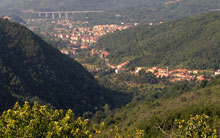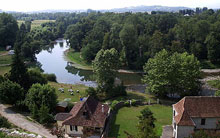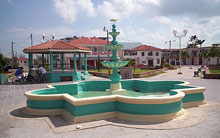Would you consider retiring in another country? I would, especially because I have already lived in another country. Living in another culture keeps us open, learning, stretching and encountering new experiences. Learning another language gives us another way to interpret and view the world. In the end, this is what life is about.
The book A Year in Provence by Peter Mayle (also a film) will give you an entertaining and humerous look at one American couple’s experience retiring to Provence, France. Great summer reading.
Meanwhile, in Donna Fuscaldo’s article, 8 Great Places to Retire Abroad, these three locations stand out: Lunigiani Italy, Bearn France and Belize. They have their advantages but disadvantages too. True for any locale.
Here’s an exerpt. Remember, you can live in many countries for far less than it costs to live in the U.S. – worth checking out. Read on.
 ©William Domenichini |
Lunigiana, Italy
Population: 130,000
Climate: Temperate. Summers can stretch from April to October, with temperatures from the mid 70s to low 90s. In winter, it’s in the 50s and 60s.
Proximity to airport: Major airports in Pisa, Genoa and Parma are all about an hour’s drive from the Lunigiana region. There’s very limited nonstop service to the U.S. Expect to make a connection.
Access to health care: Italy ranks second (tied with Spain) out of 25 countries on International Living’s Global Retirement Index for health care. Towns in the Lunigiana region with hospitals include Aulla, Fivizzano, La Spezia, Pontremoli and Sarzana. Pharmacists are found in most villages. Italy offers residents, including U.S. citizens legally residing in Italy, access to its national health plan, though many Americans opt instead to use private hospitals, which tend to provide better care than public ones.
Cost of living: Italy tied for 11th (with Uruguay) on the Global Retirement Index for cost of living, but 18th for real estate. A retired American couple can live comfortably on about $2,500 a month.
The draw: Tuscany on the cheap. The Lunigiana region of northern Tuscany is home to a network of villages connected by well-marked hiking paths. The Mediterranean coast is a short drive away, and Florence, Lucca and Pisa are all manageable day trips. Lunigiana isn’t on the radar of too many retirees yet, which means the region is more affordable than areas farther south in the heart of Tuscany. Italy has a Social Security agreement with the U.S. that can benefit people who’ve worked in both countries.
 ©Bearn Sebb |
Bearn, France
Population: 350,000
Climate: Seasonal. Temperatures range from the 30s to 50s in the winter and the 70s to 80s in the summer.
Proximity to airport: The main airport is in Pau. No nonstop flights to the U.S., but easy connections via Paris, London and elsewhere.
Access to health care: France is tops on International Living’s Global Retirement Index for health care. There are several hospitals in the Bearn region, including in the towns of Pau, Orthez, Oloron-Sainte-Marie, Mauleon, Tardets and Mourenx. Private medical insurance is required of non-E.U. residents. The Association of Americans Resident Overseas offers a group plan.
Cost of living: France ranks 18th on the Global Retirement Index for cost of living. A retired American couple can live comfortably on about $2,000 a month.
The draw: Basque in the moment. The Bearn area of southwestern France, near the border with Spain, is influenced by Basque culture from both sides of the Pyrenees (note the berets). The pastoral landscape is dotted with medieval towns, and hunting and fishing are favorite pastimes. There are loads of markets and vineyards to explore, not to mention a fair share of churches and castles. Living in Bearn is cheaper than in better-known parts of France such as Provence, a plus for retirees. France also has an agreement with the U.S. that provides Social Security advantages for people who’ve worked in both countries.
 ©Marrovi |
Corozal Town, Belize
Population: 9,901
Climate: Warm year-round, with temperatures mostly in the 80s. Mild rainy season starts in June. Risk of hurricanes.
Proximity to major airport: It’s a short commuter flight via San Pedro — each leg is less than half an hour — to the country’s main airport in Belize City, where connections are available to the U.S.
Access to health care: Corozal Town has its own hospital. More extensive medical options are available ten miles away in Chetumal, the capital of Mexico’s state of Quintana Roo. Belize ranks 24th out of 25 countries on International Living’s Global Retirement Index for health care.
Cost of living: Belize is second on the Global Retirement Index for cost of living, but 19th for real estate. A retired American couple can live comfortably in Corozal Town on $2,500 a month.
The draw: The best of both worlds. The town, located in northernmost Belize, offers retirees beaches and tranquility in Corozal, and big-city amenities such as malls and museums just across the border in Chetumal, Mexico. English is the official language, though Spanish is widely spoken. The government operates a “qualified retired persons” program that allows non-Belizeans to enjoy perks such as tax-free imports of household goods, cars and even airplanes. One-time application and program fees add up to $1,350, plus another $750 per dependent.
You may also like Antique Bookstores in Paris, The Doors of Dublin and From Dublin to Juarez.
[…] may also like Live a Little, Prairie Walk and Simplify, Simplify, Simplify. This entry was posted in About Justice, Creative […]